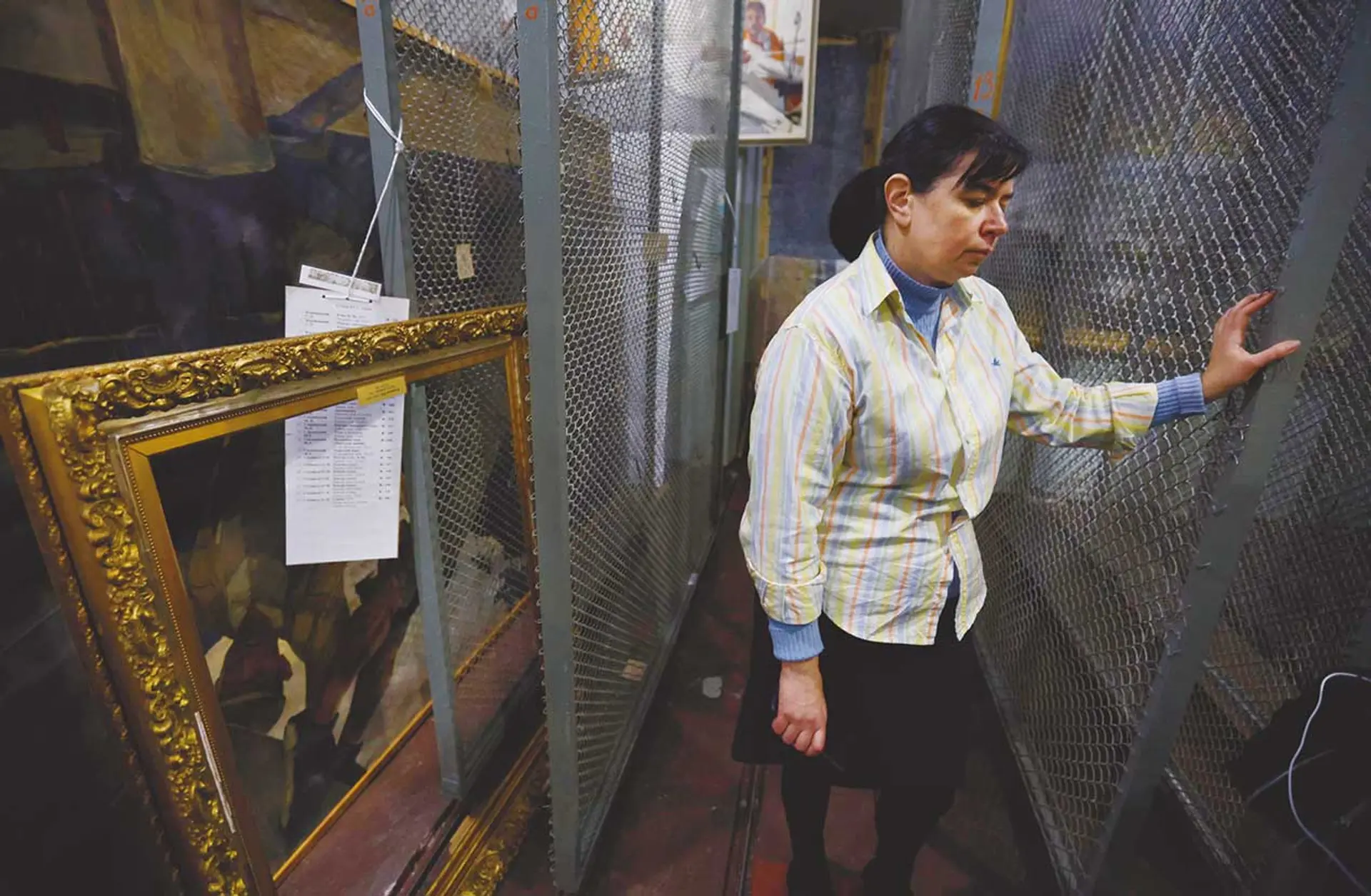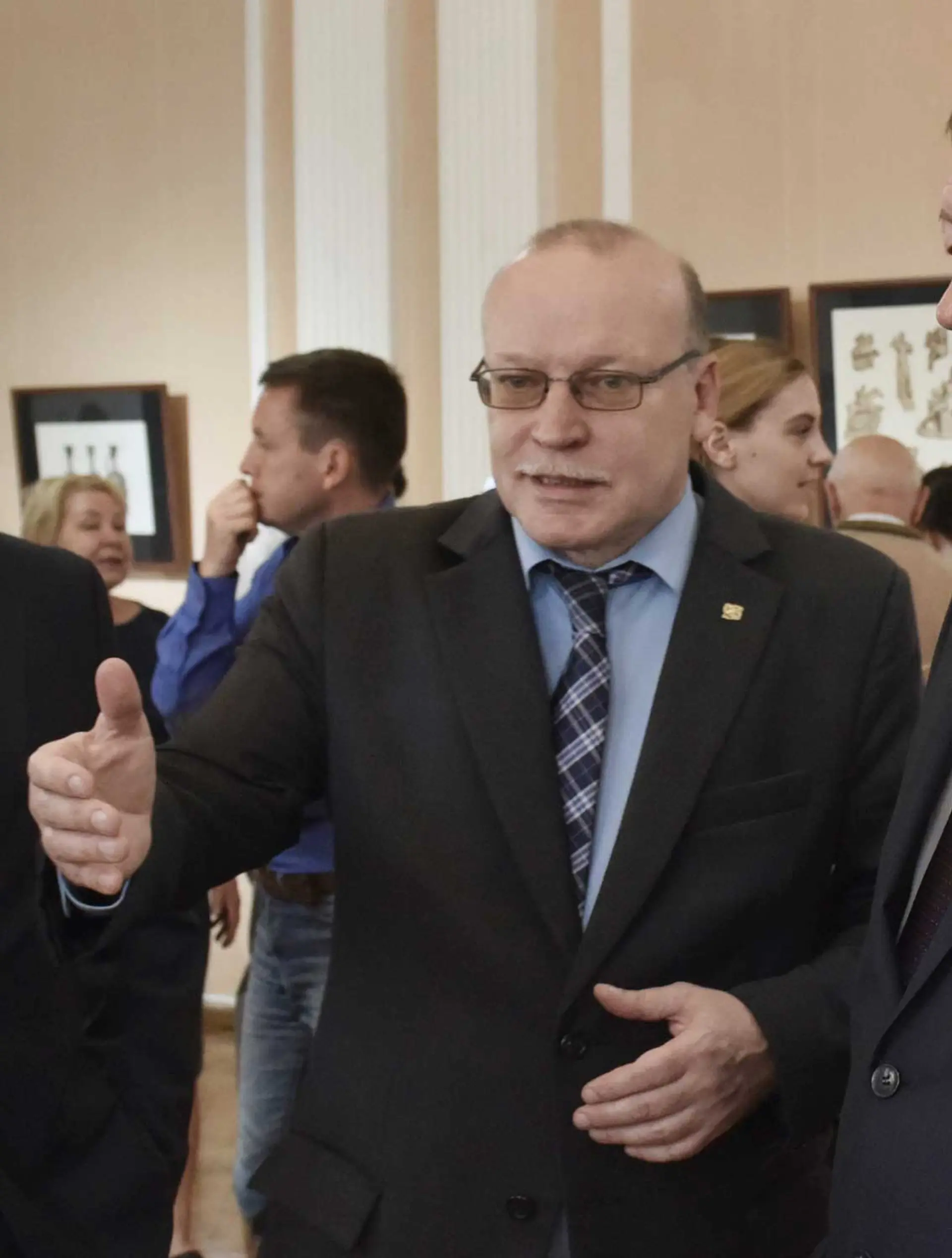News:
Special investigation: Serious concerns over fate of Ukraine’s museum works taken by Russians
By Martin Bailey
The Art Newspaper probes the complex issues arising from the removal of the Kherson Museum’s collection, sent to Crimea for “safekeeping”
The deputy director in the storeroom of the Kherson Regional Art Museum after the works were seized
An investigation by The Art Newspaper raises serious concerns that works of art taken by Russian troops in occupied Ukraine may not be repatriated once the fighting ends. Hundreds of paintings were removed from the Kherson Regional Art Museum in November and dispatched to Simferopol in Crimea, a territory seized by Russia in 2014. Other Ukrainian museums have suffered similar fates.
Works from the Kherson museum are now stored in a concert hall in Simferopol’s art museum (part of the Taurida Central museum), which is under the directorship of Andrei Malgin. According to our Inquiries, the Simferopol-born Malgin is close to Vladimir Putin and has been a vocal supporter of the Russian takeover of Crimea.
Were Kherson’s paintings moved to Simferopol for safekeeping, as the Russians argue? Or were they taken as war loot, as the Ukrainians believe? As Ukraine approaches the first anniversary of Putin’s invasion on 24 February 2022 and the ninth anniversary of the Russian occupation (20 February 2014) and subsequent annexation of Crimea, we probe into the complex issues arising from the Kherson loss.
Between 31 October and 4 November 2022 up to 40 people arrived at the Kherson Regional Art Museum (also known as the Oleksiy Shovkunenko Museum), including Russian troops and art specialists. They quickly gained access to the storeroom, where the paintings were being kept, and most were removed and loaded onto trucks.
The destination was Simferopol, Crimea’s second largest city, 260km away. There the pictures were put into storage at the Simferopol Art Museum.
Cream of the collection
Hanna Skrypka, the deputy director of the Kherson museum, said that 10,000 of their 13,500 works of art were taken. Although she was cited as saying that they were mostly paintings, a regional museum could hardly have had that many. Possibly other works included drawings, prints and coins. But it is incontrovertible that the cream of Kherson’s important collection was removed.
The city of Kherson had been taken by Russian forces on 2 March 2022, just a week after the invasion, and it was occupied for eight months. In late October, Ukrainian troops were advancing, entering Kherson on 11 November, a week after the removal of the art. There was always a risk that the art museum might have suffered from bombing and its store does not seem to have been in a protected basement.
From a safety point of view, the risks of loss during fighting or private looting in anarchic conditions needed to be balanced against the risk of transporting the paintings by truck through an area very close to the frontline. Although it is difficult for an outside observer to make a judgment, it would arguably have been safer to have left the paintings in the Kherson store. As it turned out, the museum building survived unscathed. In Simferopol the pictures are being held in the museum’s concert hall, not the ideal place for storing fine art.
Since Kherson is part of Ukraine, Oleksandr Tkachenko, Ukraine’s culture minister, is calling for the return of the museum’s collection, saying that Russia is trying to destroy his country’s culture.
The Kherson paintings date from the 17th to 20th centuries. They include Ukrainian icons that are all that remained from churches destroyed during the communist period.
A few days after the works’ removal, Malgin commented to The Moscow Times,
published in Amsterdam: “Due to the introduction of martial law on the territory of the Kherson region, I have been instructed to take the exhibits of the Kherson Art Museum for temporary storage and ensure their safety until they are returned to their rightful owner.”
Malgin records that he was “instructed”, which suggests that he was ordered by the government of Russian-run Crimea. Return to their “rightful owner” may sound reasonable, but the Russian authorities may well have a very different view from those in Ukraine. They may be intending to only return the art if Kherson again falls under Russian rule.
Andrei Malgin, the director of Simferopol Art Museum, has close links to Russian President Vladimir Putin
Our investigations, revealing close ties to Putin, comes from the Russian leader’s “President of Russia” Kremlin website, where the key information on Malgin is in an official English translation.
The Kremlin website records that Malgin was present at two meetings with Putin. On 10 April 2014 he was among core members of the Russian Popular Front who met Putin near Moscow. Malgin then held a senior political appointment, as co-chairman in Crimea of the front, an organisation set up by Putin in 2011.
Malgin, who sat in the very middle of the front row, was among four of the political organisation’s members who spoke. He addressed Putin: “When Crimea joined Russia [a month earlier, in March 2014], it was not just joining the territories and peoples; it was also about joining an entire layer of our common past, common history.”
He went on to comment that independent Ukraine had failed to care for its museums in Crimea: “Ukraine had neither the money nor the desire to look after things and sites that are part of our Soviet, imperial, Russian history.” Putin immediately responded: “The museums there [in Ukraine and Crimea] have very rich collections, dealing with our heroic past, our culture and literature.”
A further meeting attended by Malgin was held on 18 March 2021, this time by video (under Covid-19). He praised the recent Russian military incursion into Ukraine, arguing that its purpose was to defeat Nazism: “Seven years ago now [when Russia took over Crimea], we, too, faced a reviving Nazi ideology... This is the main reason why today we are part of Russia.” Putin responded: “Thank you very much and I wish you every success.”
Few outsiders believe that Ukrainian governmental policies bear any resemblance to Nazi ideology.
The question now is who is the “rightful owner” of the Kherson collection? Unesco’s position is clear: under the 1954 Hague Convention and its protocol, “when the occupation ends [after an armed conflict], the state must return the cultural object[s] to the formerly occupied authorities.” Both Russia and Ukraine are signatories.
Following the removal of the works, Kherson’s police opened a criminal investigation into what could turn out to be a war crime.

The highlights of Kherson Regional Art Museum were published in a catalogue in 1987
Malgin had earlier been involved in a legal case to recover Scythian gold treasures, which were lent by four Crimean museums to an exhibition at Amsterdam’s Allard Pierson Museum in 2014, The Crimea: Gold and Secrets of the Black Sea. When the show ended, two months after the Russian takeover of Crimea, both the Ukrainian and Crimean authorities demanded that the objects should be returned to them.
This resulted in a lengthy legal battle in the Dutch courts, which led to a Ukrainian victory (since the museums’ collections are state-owned) although it may still go to the supreme court for an appeal. Malgin was the key museum director calling for the gold to be returned to Crimea. After hearing the verdict, Tass, the Russian state news agency, reported that he was “speechless with anger and indignation”.
The disasters of war
The story of the Simferopol museum is a reminder of how political and military developments have disastrously impacted on Ukraine’s heritage over the past 100 years. After the 1917 Russian Revolution the Communist government confiscated private art collections and nationalised them, leading to the establishment of the Simferopol museum in 1922. At this time Crimea was a republic within the Soviet Union.
During the Second World War, Simferopol’s paintings were sent for safekeeping to Kerch, 200km away. This turned out to be a disastrous decision. German troops first seized Kerch in 1941, and after intense fighting it was recaptured later that year by the Red Army. In 1942 Kerch was taken again by the Germans, who occupied the city until 1944. At some point the building where the Simferopol paintings were stored was bombed, resulting in the total destruction of the art. There was also a terrible loss of military and civilian lives.
After the war the Soviet government generously sent paintings from Moscow’s Tretyakov Gallery and Leningrad’s (now St Petersburg) Russian Museum and State Hermitage Museum. What may come as a surprise is that Simferopol also received paintings belonging to Aachen, a German city near the Dutch and Belgian borders.
During the war the Aachen paintings, from the Suermondt Museum, had been moved for safekeeping to the Albrechtsburg castle in Meissen, near Dresden, to protect them from the British bombs that devastated the city. In 1945 the pictures were seized by the Red Army and taken to Moscow, from where they were later dispatched to Simferopol. By this time the art had travelled over 4,000km from Aachen.
The Aachen paintings were consigned to a storeroom and their existence kept a secret. It was only in 2008 that some were put on display. At this point the Aachen museum made contact with Simferopol to discuss co-operative arrangements and the possible return of the paintings. These talks ended with the Russian takeover of Crimea in 2014.


